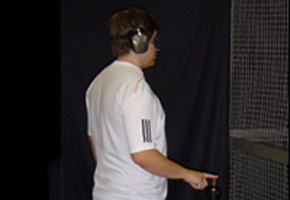

Study shows that application of low-level vibratory noise to a surface amplifies tactile signals, improving postural stability in blind subjects
Study shows that application of low-level vibratory noise to a surface amplifies tactile signals, improving postural stability in blind subjects
Study shows that application of low-level vibratory noise to a surface amplifies tactile signals, improving postural stability in blind subjects

Study shows that application of low-level vibratory noise to a surface amplifies tactile signals, improving postural stability in blind subjects
By Fábio de Castro
Agência FAPESP – A single finger in contact with a static surface improves postural stability—and consequently the balance of a visually impaired individual. Researchers at the Universidade de São Paulo (USP) managed to demonstrate that the application of a random vibration to a contact surface results in even better postural stability.
The study, performed at the Biomedical Engineering Laboratory, Universidade de São Paulo’s Polytechnic School, suggests that the vibration amplifies the tactile signals that reach the brain, which is then able to improve motor performance. According to the authors, the study opens pathways to future applications in the rehabilitation of patients with physical impairments.
The study which is part of the Fernando Magalhães’ doctoral researcg is being completed through a FAPESP scholarship in the USP Neuroscience Post-Graduate Program under the orientation of professor André Fábio Kohn. The results were published in Experimental Brain Research magazine.
According to Kohn, in the experiment a blindfolded subject placed their index finger on a surface that vibrated randomly at controlled noise intensities. The result was decreased postural sway, a sign of improved postural stability.
“Without the vibration, contact between the fingertip and the contact surface would provide a fixed reference to the ground—which is an additional reference in relation to those provided by other human sensorial receptors. The surprising discovery was that when the contact surface vibrated randomly instead of remaining static, the subject had less postural sway,” Kohn explained to Agência FAPESP.
According to him, the mechanism behind this phenomenon seems to be stochastic resonance, frequently studied by physicists and engineers, which consists of improved detection of weak signals when a low-level intensity random signal is presented together with them.
“Stochastic resonance can be applied to a large family of sensory receptors located not only on the skin surface but also in many cutaneous regions, joints and muscles. A certain number of them are activated by contact with a stable surface. When low level vibrational noise is applied to the surface, many other receptors which before had not been activated finally signal the oscillation, improving motor performance,” he explained.
According to Kohn, studies conducted by a team led by Professor Elias Manjarrez at Mexico’s Universidade Autônoma de Puebla had shown that human brain signals captured in response to vibrations at the fingertip could be amplified by adding a random vibration to the initial vibration.
“They showed that adding the small vibration caused the signal to be captured by the brain. We managed to go one step further and show that this signal, which is amplified by stochastic resonance, could in fact be used by the nervous system, giving stronger feedback for those signals,” he affirmed.
Specific experiments need to be conducted in order to discard the hypothesis that the vibration reduces postural sway merely by alerting the subjects with the vibration. Other experiments were also significant in showing that there was in fact a resonant response curve when the intensity of the random vibration was varied.
“Aside from the scientific interest that a phenomenon typical of physics and engineering applications is relevant to human neuroscience, we believe that the discovery opens a pathway for possible application in devices assisting impaired individuals who use tactile information to orient themselves. For this, we will need more studies using miniature implementation of the vibratory system fixed to devices such as canes for the physically impaired,” he affirmed.
The article Vibratory noise to the fingertip enhances balance improvement associated with light touch (doi:10.1007/s00221-010-2529-3), by Fernando Magalhães and André Fábio Kohn, may be read by subscribers to Experimental Brain Research magazine at www.springerlink.com/content/y95w224087u27167.
Republish
The Agency FAPESP licenses news via Creative Commons (CC-BY-NC-ND) so that they can be republished free of charge and in a simple way by other digital or printed vehicles. Agência FAPESP must be credited as the source of the content being republished and the name of the reporter (if any) must be attributed. Using the HMTL button below allows compliance with these rules, detailed in Digital Republishing Policy FAPESP.




